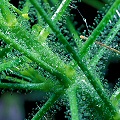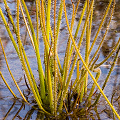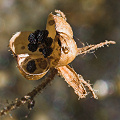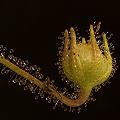Q: Byblis: cultivation
A: Byblis likes conditions a little drier than typical
sundews. Other than the refinements I give below, treat your plant as a sun-loving, frost-hating,
carnivorous plant and you should do well. That said, the only time I have seen plants in this genus in the wild, it
was Byblis gigantea which was growing equally well
in both moist sand and shallow ephemeral ponds. Clearly, the real secret to growing this plant
does not rest in mere moisture details alone.
The B. liniflora complex plants are easy to grow. They are not too picky about soil medium, but I
have had the
best results growing them in 2:1 sand:peat. Meanwhile, they do OK in really wet mixes like pure Sphagnum,
so you see the mix is not too crucial. They do not mind sitting in water. I find the most important thing with these plants is to give
them a big pot, at least 8 cm (3 inches) across. A smaller pot will result in a smaller plant.
Unless the plants are tiny, do not repot them. They will not like it at all.
Another problem with these plants is that until they are a few cm tall, they are very prone to fungal death.
The most beautiful plants in cultivation, in my mind, are grown by the amazing Japanese horticulturist Isao Takai. Isao-san has a collection of
spectacular beauty, with many flower colors and forms. Wow. I'm sure if you google his name (add Byblis to your
search string) you will see photographs from his collection.
Byblis gigantea (and presumably, although I've never grown it,
B. lamellata) prefers a very sandy mix in a big pot, top-watered only.
It can be a trick to get Byblis to produce seed. Byblis liniflora
produces seed readily without intervention (at least for forms in common cultivation). The other species all appear to
require cross-pollination, which means you need multiple specimens. I find that over time, inbreeding sets in with my plants
and they lose vigor over a few years. I do not have a solution for this other than maintaining a large set of plants to assure
enough genetic diversity.
However, this is apparently not an issue for everyone,
because Isao-san has been doing amazing horticultural things with his B. filifolia,
and has developed really beautiful, floriferous forms.
Field researchers report that when certain bees visit the flowers, their buzzing wings vibrate the flowers and shake the pollen
out of the anthers. This has resulted in the oft-told story that tuning forks must be used to obtain pollen from cultivated
plants. This is a great idea, but in my experience it simply is not the case. I collect pollen by simply knocking the anthers a
few times. Pollen tumbles out readily enough, and no tuning fork is required..
Germinating seed, especially for B. gigantea, may require a gibberellic acid treatment, or perhaps
a pot fire. The seeds do not necessarily need to be fresh; B. gigantea seeds 22 years old have
been germinated after a pot fire!
For further information, refer to my article
on cultivating these plants.
Page citations: Conran, J.G. et al. 2002;
Hartmeyer, S. 1997, 1998; Lowrie, A. & Conran, J.G. 1998; Rice, B.A. 1993, 2006a; Schlauer, J. 2002;
Ziemer, B. 2008; personal observations.



